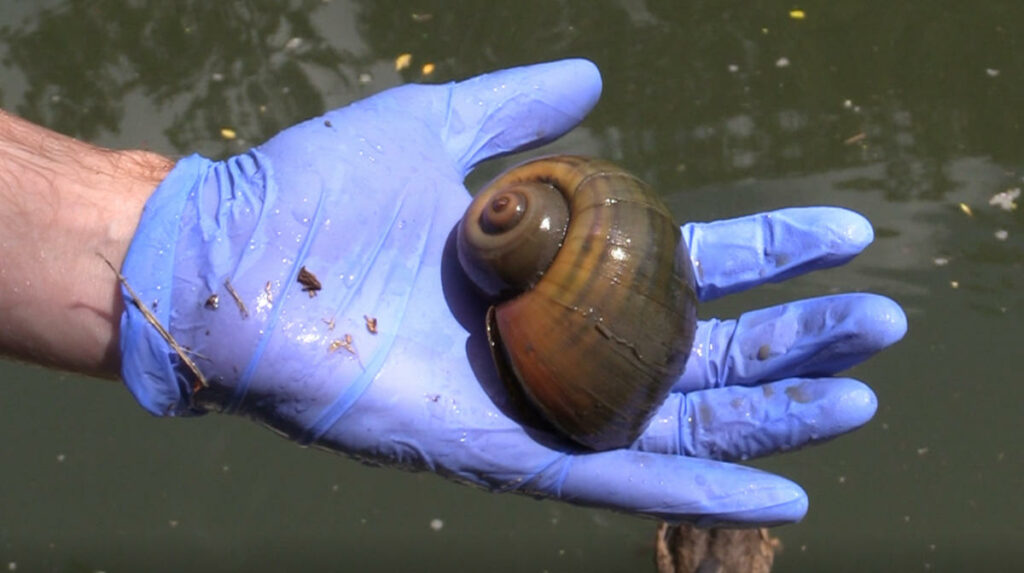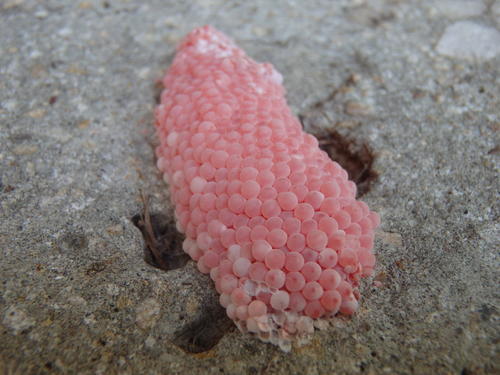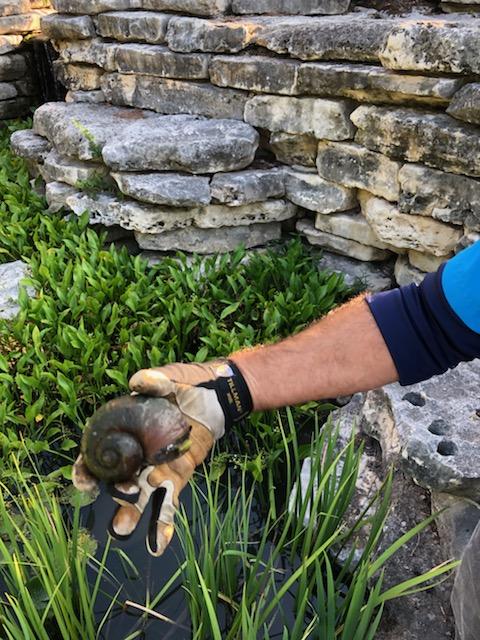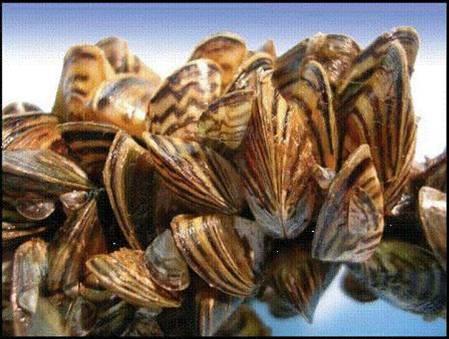An ecosystem can be described as the connection between a community of living things, such as plants, animals, and microbes, and the nonliving environment such as air, climate, water, and minerals that surrounds it. The San Antonio River Authority (River Authority) is proactive when it comes to protecting our natural resources and staff has been hard at work to address invasive species as part of our commitment to safe, clean, and enjoyable creeks and rivers.
One of the most recent threats facing the San Antonio River watershed is the invasive apple snail. River Authority biologists first responded to the observation of apple snails along the section of the San Antonio River Walk in October 2019. Learn more about this non-native species and what the River Authority is doing to address its presence.

Apple Snails: Big Snail, Even Bigger Problem
On a walk or boat ride along the San Antonio River Walk, you may have seen some bright pink blobs above the water line adhering to the concrete or other structures. These are apple snail (Pomacea sp.) egg cases, and each egg case can contain thousands of eggs.
Apple snails are native to South America, and they are a threat to the San Antonio River ecosystem. This snail species has no natural predators in our area and their populations are continuing to increase. Apple snails thrive in the warm, slack waters of the downtown. Museum, and King William stretches of the San Antonio River and can reproduce continuously for eight to nine months of the year. The snails are voracious eaters of aquatic plants which can be detrimental to native aquatic organisms that rely on plant resources for things like habitat, foraging, and rearing their young. Depleting native aquatic plant populations can also have effects on a system’s ability to regulate water quality.

You may be wondering how the apple snail came to live in the San Antonio River. These snails were most likely purchased at a pet store or were uninvited stowaways on plants that were purchased by aquarium hobbyists. Full grown, these snails can be the size of a softball! Once the snails got too big for the aquarium, people may have been unsure of what to do with them and in an uninformed attempt to be compassionate, released them into the nearest waterbody.
The apple snail population increase is difficult to mitigate as they have many surprising adaptations. The apple snails avoid the ill-effects of a deep freeze, like the one in San Antonio in Winter 2021, by burrowing deep into the river’s natural sediment bottom and banks. While these snails lay their eggs above the waterline for respiratory and development reasons, it just so happens that the eggs benefit from staying out of the mouths of predatory fish. This snail is difficult to see, too, with green-brown shells camouflaged against the river bottom and other natural materials. The apple snail can also float, allowing it to be easily be carried around a waterbody and lay eggs in new locations.
How does the San Antonio River Authority work to mitigate the apple snail population?

The San Antonio River Authority (River Authority) is proactive when it comes to protecting our natural resources and staff have been hard at work to address invasive species as part of our commitment to safe, clean, and enjoyable creeks and rivers.
River Authority Environmental Science staff,Watershed and Parks Operations staff, and River Authority partners work together to survey the river and have apple snail egg cases and adults collected, permanently removing them from the San Antonio River. Workers visit the Museum Reach section of the River Walk every 10 days to remove every egg case and snail they can find. This 10-day window is an advantageous tactic to mitigation of population growth because the developing snails in the egg cases take approximately 10 to 14 days to mature and hatch. Therefore, as best as possible, the collection and removal of the egg cases stays ahead of the hatching cycle of the snail.
It is illegal to possess or transport apple snails. The River Authority has been granted the ability to work with members of the public to collect both adults and egg cases, through a training process by Texas Parks and Wildlife Department (TPWD). People interested in helping to mitigate the apple snail population growth can join the River Authority’s River Warriors volunteer group. The skilled science and volunteer staff will equip volunteers with the methods to remove the snails and their egg cases from the San Antonio River. By attending this training, individuals can collect and promptly dispose of adult apple snails by way of Active Partner Status through the TPWD.
If you are interested in helping us manage this invasive species or participating in any of our other volunteer service projects or educational trainings, please sign up and join the River Warriors.
Being Helpful from Home
Please remember, never dump your aquarium into the river or any other natural waterbody. You can keep up with the San Antonio River Authority efforts regarding apple snails and other invasive organisms, by following the River Authority on social media channels and by following the River Authority Blog.
Zebra Mussels: Help Stop the Spread

Invasive Zebra Mussels have been discovered in lakes and waterways in South Texas. The San Antonio River Authority has begun coordinating efforts to reduce the risk of this damaging mussel affecting the San Antonio River Watershed.
Zebra mussels are native to Russia and the Ukraine. They were first detected in the United States in the Great Lakes and Hudson River in the 1980s. Since then, they have steadily made their way across the United States by hitching rides on boats traveling between streams and lakes.
Zebra Mussels multiply rapidly and the few natural predators in Texas waterways have little effect on their spread. Infested streams and lakes have reported colonies of zebra mussels taking over habitats and nutrients from native fish and mussel colonies.
They can also interfere with recreation and wreak havoc on important infrastructure. Recreational users may face encrusted boat hulls and mechanical systems and damage to fishing equipment. Municipal water supply intake pipes and pipelines can become fully blocked as they are colonized by zebra mussels.
The River Authority’s goal is to stop this spread from reaching the San Antonio River watershed. Texas Parks and Wildlife Department (TPWD) and The River Authority advise both motorized and non-motorized boat recreationalists to do the following:
- Clean your watercraft, anchor, trailer, and gear. Remove any plants, animals or foreign objects.
- Drain all water from your watercraft and completely empty your bait buckets to rid them of possible microscopic zebra mussels and larvae.
- Dry everything for a week or more before entering another water body. If unable to dry it completely, wash it with high-pressure, hot (140° F), soapy water.
You can also help to stop the spread by reporting any new sightings to TPWD. Visit TPWD’s www.texasinvasives.org website to learn more.
What can I do to help?
Please remember, never dump your aquarium into the river or any other freshwater or saltwater body. You can also report any sighting of egg cases or adult snails by calling toll free at (866) 345-7272 or contact us through our website. Your help with reporting this invasive species will assist our Environmental Sciences Team to further study and remove the presence of this non-native species along our creeks and rivers. Finally, we will soon be training volunteers to help us track and remove apple snail egg cases. If you’re interested in helping us manage this invasive species or participating in any of our other volunteer service projects or educational trainings, please sign up and join the River Warriors.

